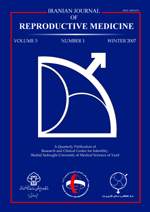
|
International Journal of Reproductive BioMedicine
Research and Clinical Center for Infertility, Shahid Sadoughi University of Medical Sciences of Yazd
ISSN: 1680-6433
EISSN: 1680-6433
Vol. 15, No. 4, 2017, pp. 217-224
|
 Bioline Code: rm17029
Bioline Code: rm17029
Full paper language: English
Document type: Research Article
Document available free of charge
|
|
|
International Journal of Reproductive BioMedicine, Vol. 15, No. 4, 2017, pp. 217-224
| en |
Valproic acid induces histologic changes and decreases androgen receptor levels of testis and epididymis in rats
Iamsaard, Sitthichai; Sukhorum, Wannisa; Arun, Supatcharee; Phunchago, Nichapa; Uabundit, Nongnuch; Boonruangsri, Porntip & Namking, Malivalaya
Abstract
Background: Valproic acid (VPA), an anti-epileptic drug, can cause male subfertility. However, the degree to which testicular and epididymal histopathologies and androgen receptor (AR) expression are changed under VPA treatment has never been reported.
Objective: To investigate the histopathological changes and AR protein levels of testis and epididymis in VPA-treated rats for every single day.
Materials and Methods: Sixty-four adult male Wistar rats were divided into
control and VPA-treated groups (n=8/ each). Treated rats were injected with 500
mg/ kgBW, intraperitoneally, VPA for 10 consecutive days. At the end of every
experimental day, all reproductive parameters including histology by hematoxylin
and eosin staining and protein expression of AR by Immuno-Western blot in testis
and epididymis were examined.
Results: VPA-treated rats showed dramatically changes in testicular and epididymal histopathologies compared to control group. The multinucleated giant cells and sloughing of germ cells were observed on day 6. The germ cell disintegration and increased intercellular spaces of seminiferous tubular epithelium appeared in days 7-10 of VPA treatment. Additionally, extensive multinucleated giant cells and complete exfoliation were clearly found from days 8-10. Such exfoliated germ cells were clearly seen in its epididymal lumen at day 10. The increasing rate of sperm concentration was approximately 32.31% of that in control group at day 10 (p=0.03). Moreover, the protein expressions of testicular and epididymal AR (% intensity/ 80 μg protein lysate) was decreased in VPA-treated rats compared with control.
Conclusion: VPA treatment induces histologic changes of germ cell epithelium in seminiferous tubules and decreases the expression of testicular and epididymal androgen receptors.
Keywords
Valproic acid; Testis; Epididymis; Histopathology; Androgen receptor
|
| |
© Copyright 2017 - Iranian Journal of Reproductive Medicine
Alternative site location: http://www.ijrm.ir
|
|
